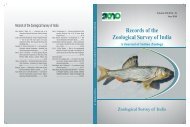Andaman booklet aw.FH10 - Zoological Survey of India
Andaman booklet aw.FH10 - Zoological Survey of India
Andaman booklet aw.FH10 - Zoological Survey of India
You also want an ePaper? Increase the reach of your titles
YUMPU automatically turns print PDFs into web optimized ePapers that Google loves.
<strong>Andaman</strong> H<strong>aw</strong>k Owl Ninox affinis : It is a Near Threatened species<br />
and endemic to the <strong>Andaman</strong> and Nicobar archipelagos, where it<br />
occurs in the mangrove forest, lightly wooded areas and forest<br />
clearings, and is commonly seen h<strong>aw</strong>king insects at dusk (BirdLife<br />
International, 2001). It is found in North, Middle and South <strong>Andaman</strong><br />
Islands and is reported from some <strong>of</strong> the IBAs such as Rani Jhansi<br />
Marine NP, Tillanchong, Camorta, Katchal, Nancowry, Trinkat, Saddle<br />
Peak NP, Jar<strong>aw</strong>a Reserve, Kadakachang, Austin Strait, Mount<br />
Diavalo/Cuthbert Bay, Mahatma Gandhi Marine NP, and other IBA<br />
sites (Islam and Rahmani, 2009)..<br />
Narcondam Hornbill Aceros narcondami<br />
: This endemic and vulnerable hornbill has<br />
a very small population on a tiny, island less<br />
than seven sq. km in area known as<br />
Narcondam Island. Its population is stable<br />
since feral goats were culled by the armed<br />
forces. It is roughly estimated that about 68-<br />
85 breeding pairs are present on the island<br />
(BirdLife International, 2001), with a<br />
population <strong>of</strong> about 400 hornbills (Yahya<br />
and Zarri, 2002).<br />
Nicobar Bulbul Hypsipetes nicobariensis: This bulbul is one <strong>of</strong><br />
the 78 globally vulnerable species with a small, declining population<br />
as a result <strong>of</strong> the clearance and degradation <strong>of</strong> forests for plantation,<br />
agriculture and infrastructure projects (BirdLife International, 2001).<br />
This bird is endemic to the Nancowry group <strong>of</strong> Islands in the Nicobar<br />
islands (Abdulali, 1965).<br />
South Nicobar Serpent-Eagle Spilornis klossi: This Eagle which is<br />
treated as separate from "Nicobar [or Small] Serpent-eagle S.<br />
minimus", which is instead provisionally placed with S. cheela) is<br />
endemic to the islands <strong>of</strong> Great Nicobar (including Pulo Kunji), Little<br />
Nicobar and Menchal in the South Nicobar island group, Nicobar<br />
islands (Richmond 1902, Abdulali 1967, 1978, Sankaran 1998).<br />
Nicobar Parakeet Psittacula caniceps: This Parakeet Near Threatned<br />
and endemic to the Nicobar archipelago, where it inhabits tall forest<br />
on Great Nicobar, Little Nicobar, Menchal and Kondul islands, feeding<br />
in small groups in the canopy on the fruit <strong>of</strong> Pandanus palms<br />
(Grimmett et al., 1998). It is apparently common, but fairly large<br />
numbers are trapped for the cagebird trade (del Hoyo et al., 1997).<br />
21
















